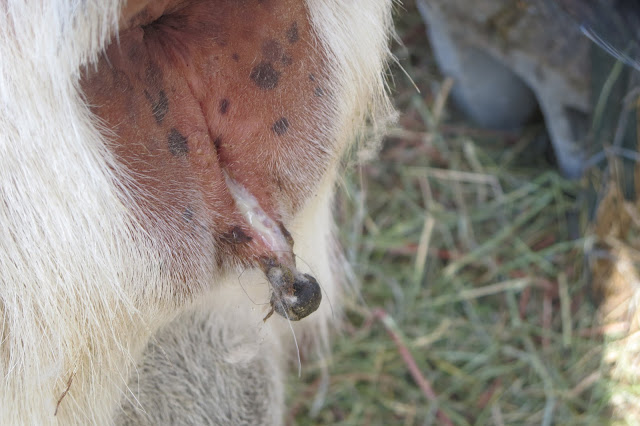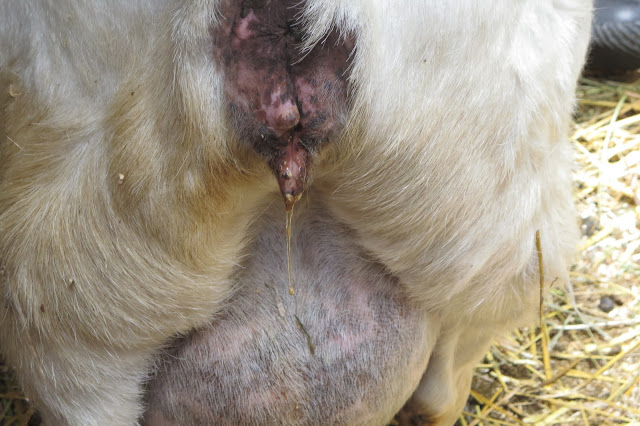I've had a few questions here in person about goats and signs that they are getting ready to give birth and what sort of discharge is good and what is bad. I thought I'd do a post on that in case anybody else is interested.
Just a warning, there will be lots of pictures of goat butts and various substances coming out of them.
The one I get the most seems to be about whitish/yellowish goo on the hind end. Such as this.
This is the mucus plug coming out. This generally happens anywhere from 2 weeks before birth up until the big event itself but I have one goat that consistently loses hers about a month beforehand. As long as the goat is acting fine and there isn't a bad, infection like smell, things are fine. Sometimes you'll see the dried goo on the vulva, it looks like a nasty yellowish/greenish booger, but again, it's fine.
Signs to be watching out for that signal things are getting down to business generally start with ligaments disappearing. These run from the tail head down to the pin bones. You can google some good pictures that show were they are. It's good to find them way before hand or check on a doe that is not pregnant so you know where they are and what they feel like. They will soften up before hand, how far before and how soft depends on the goat. Sometimes they'll get really soft, then get harder or there'll be one on one side and the other is gone. This can go on for a couple weeks, but at some point they will disappear. If the goat has shorter hair, you often can see little hollows there on each side of the tail. You can almost touch your fingers together under the tail. Once these ligaments are gone, you will usually have babies within 12 hours.
Most, but not all, goats will show a clearish to amberish goo a few hours before birth. This will be a lot more stringy and snotty like than the mucus plug goo. Although sometimes they will be mixed if the doe held onto her plug til birth.
If they are leaking amniotic fluid, they will often keep licking it up. They often are talking to the babies as well, even if they are not there yet. Sometimes the do will be clingy and unsure. Sometimes they will try to mother you, licking you and making their special baby noises. Some does, though, don't want anyone around them at this time. Every doe is different, but once you get to know your animal, it'll provide with more information about what's happening and if something is wrong.
Another thing to look for is a sunken belly because the babies have dropped to get ready to come out. This can be easily confused with a hungry goat that hasn't been fed until you see it. If it's your first it's especially confusing but once you have seen the "I'm ready to have babies" sunken belly compared to the "where's breakfast?" sunken belly it becomes more obvious.
Most does also tend to carry their tail different at this time. Mine are either flopped to the side, like it's too much work to keep it up or the are lifted up over the back.
You can also look for things like the udder bagging up, but this is highly individual. If you watch your doe and take notes, it'll help you future kiddings because you'll know what that doe does. For instance, this doe in the picture bags up weeks before kidding while my alpine doe doesn't really bag up til a few days AFTER kidding. She does a little, but not much.
Posture can sometimes tell you something too. Mine usually don't get funny with that til in labor, but some do. You can see how the doe in the picture below is standing different than a normal goat. You can also see her sunken belly. Usually by the time you see this, things are starting!
So, these are some pre and early kidding signs. I'll do another post later about the kidding itself.










Wow! That was quite a lesson! I'm hoping to raise goats one of these days. Thanks much!
ReplyDeleteGlad you liked it!
Delete